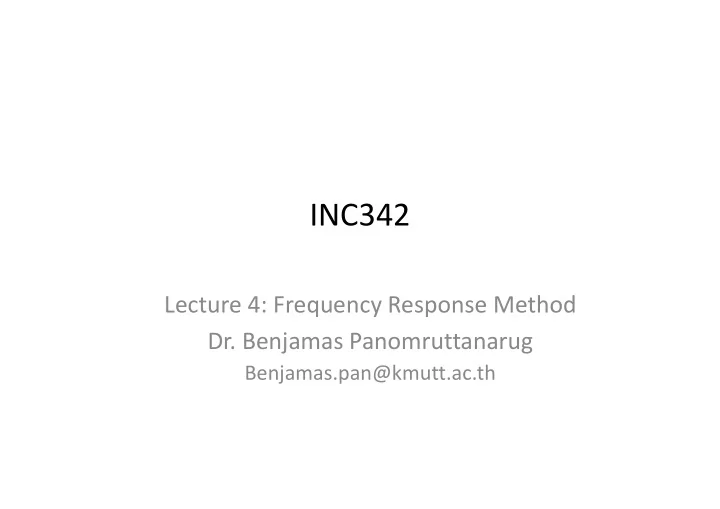

INC342 Lecture 4: Frequency Response Method Dr. Benjamas Panomruttanarug Benjamas.pan@kmutt.ac.th
Improving Transient Response Using Compensator • Objective is to – Decrease settling time – Get a response with a desired %OS (damping ratio) • Techniques can be used: – PD controller (ideal derivative compensation) – Lead compensator BP 2 INC342
Ideal Derivative Compensator • So called PD controller • Compensator adds a zero to the system at –Zc to keep a damping ratio constant with a faster response G s z C c BP 3 INC342
Example design a PD controller to yield 16% overshoot with a threefold reduction in settling time 16% overshoot = 0.504 damping ratio BP 4 INC342
Location of poles as desired is at -3.613±j6.192 BP 5 INC342
BP 6 INC342
PD Compensator K ( 1 ) G c K s K K s 2 1 2 K 2 BP 7 INC342
Improving Both Steady ‐ State Error and Transient Response • PI, Lag improve steady ‐ state error • PD, Lead improve transient response • PID, Lead ‐ lag improve both (PID = Proportional plus Intergal plus Derivative controller) BP INC342 8
PID Controller K K 2 1 2 ( ) K s s 3 2 K s K K s K K K 2 1 2 3 3 3 ( ) G c s K K s 1 3 s s s BP INC342 9
PID controller design 1. Evaluate the performance of the uncompensated system 2. Design PD controller to meet transient response specifications 3. Simulate and Test, redesign if necessary 4. Design PI controller to get required steady ‐ state error 5. Find K constant of PID 6. Simulate and Test, redesign if necessary BP INC342 10
Example Design PID controller so that the system can operate with a peak time that is 2/3 of uncompensated system, at 20% OS, and steady-state error of 0 for a step input BP INC342 11
Step 1 • %OS = 20% damping ratio = 0.456 Ѳ = 62.87 • Search along ther line to find a point of 180 degree ( ‐ 5.415 ± j10.57) • Find a correspoding K=121.51 • Then find the peak time 0 . 297 sec T p 10 . 57 d BP INC342 12
BP INC342 13
Step 2 • Decrease peak time by a factor of 2/3 get imaginary point of a compensator pole: 15 . 867 d ( 2 / 3 )( 0 . 297 ) T p • To keep a damping ratio constant, real part of the pole will be at d 8 . 13 tan( 62 . 87 ) • The compensator poles will be at ‐ 8.13 ± j15.867 BP INC342 14
• Sum of the angles from uncompensated poles and zeros to the test point ( ‐ 8.13 ± j15.867) is ‐ 198.37 • The contribution angle for the compensator zero is then 180 ‐ 198.371 = 18.37 15 . 87 tan( 18 . 37 ) 8 . 13 z c 55 . 92 z c ด PD controller is (s+55.92) BP INC342 15
BP INC342 16
Step 3 • Simulate the PD compensated system to see if it reduces peak time and improves ss error BP INC342 17
Step 4 • design PI compensator (one pole at origin and a zero near origin; at ‐ 0.5 in this example) 0 . 5 s ( ) G PI s s • Find a new point along the 0.456 damping ratio line ( ‐ 7.516±j14.67), with an associate gain of 4.6 BP INC342 18
BP INC342 19
Step 5 • Evaluate K1, K2, K3 of PID controller ( 55 . 92 )( 0 . 5 ) K s s ( ) G PID s s 4 . 6 ( 55 . 92 )( 0 . 5 ) s s s 2 4 . 6 ( 56 . 42 27 . 96 ) s s s 2 • Compare to K s K K s 1 2 3 ( ) G c s s K1 = 259.5, K2 = 128.6, K3 = 4.6 BP INC342 20
Step 6 BP INC342 21
Physical System Realization PI Compensator C R2 1 s R1 R C R 2 Vi(s) Vo(s) ( ) 2 C s R s 1 BP INC342 22
PD Compensator R2 C 1 ( ) G s R C s Vi(s) Vo(s) 2 c R C R1 1 BP INC342 23
PID Compensator C2 R2 R1 Vi(s) Vo(s) C1 1 R C R C ( ) 2 1 1 2 G s R C s 2 1 c R C s 1 2 BP INC342 24
Recommend
More recommend